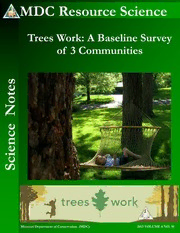
Science Notes 2013, Volume 8, Number 10 PDF
Preview Science Notes 2013, Volume 8, Number 10
MDC Resource Science Trees Work: A Baseline Survey of 3 Communities s e t o N e c n e i c S trees work TN Missouri Department of Conservation (MDC) 2013 VOLUME 8 NO. 10 Trees Work: A Baseline Survey of 3 Communities By Ann Koenig, Ron Reitz, Heather Scroggins, Tom Treiman, and Martha McCrary Information Need should be using the word “trees” not “forests” when making contacts. Forestry Division has begun a state-wide campaign focused on This supports the Trees Work campaign’s decision to target younger increasing awareness of the benefits that trees and forests provide to audiences with the goal of sustaining the messaging over a long Missourians. To be effective, this “Trees Work” campaign’s messages period of time. Also, although there were few differences between the must resonate with a wide variety of groups and population communities in this baseline data, we can expect changes as the segments, and do so in the brief opportunities. To develop and campaign is applied differentially. MDC plans to repeat the survey in evaluate such targeted messages, we must understand 1) the current the same communities after two years in order to detect any changes level of awareness of tree and forest benefits, 2) which of benefits are in awareness or attitudes. most important to Missourians, and 3) what messages are most likely to motivate people to action and what barriers prevent action toward Table 1. Percent of respondents (N=2,426) who had seen or heard sustainability of Missouri’s forests. The campaign is planned to last an environmental message, MDC Trees Work baseline survey, 2013 several years, so baseline research provides critical information for development and evaluation. Have you ever heard or seen these Do not Methods messages? Yes No know Three communities, Columbia, Salem, and Webster Groves, were Only you can prevent forest fires 96.8 1.6 0.8 chosen, not as representatives of all Missouri but as places where the campaign was about to be piloted, for a mail survey in 2013. Give a hoot, don’t pollute 86.0 9.9 2.2 Questions included respondents’ awareness of various Trees work 20.6 60.8 14.1 environmental campaigns and tree benefits, which campaign linkages were most important, and which messages they found Serving Nature and You 22.7 57.9 15.4 most resonant. MDC mailed out 6,700 surveys and received 2,426 responses, an overall response rate of 36%. Table 2. Percent of respondents (N=2,342) who agreed or disagreed Results with a benefit statement, MDC Trees Work baseline survey, 2013 “Trees Work”, when compared to long established campaigns such as “Only you can prevent forest fires”, “Give a hoot, don’t pollute” and even “No MO Trash”, has low public awareness Please indicate whether you Trees Missouri’s forests (20%). But this new campaign (which had only just appeared in agree or disagree benefit me benefit me the Conservationist) is already on a par with “Serving Nature and Strongly Agree 82.2 75.5 You” (22%, Table 1). The six message areas that MDC selected for the campaign Mildly Agree 11.7 15.6 (Trees Work For: Your Wallet, Your Health, Your Family, Your Unsure 2.9 4.6 Community, Our Environment, and Our Economy) appear to have been well chosen. Over 80% of respondents said they Mildly Disagree 0.3 0.3 would be “Very Interested” or “Somewhat Interested” in learning Strongly Disagree 0.5 0.6 more about each area. Several messages tested in the survey stood out, with over 45% of respondents saying they would share the message, “Shade from two large trees can save up to 30% of a typical residence’s Table 3. Percent of respondents (N=2,426) who had seen or heard annual air conditioning costs,” with a friend or family member, an environmental message by age group, MDC Trees Work baseline and over 35% saying the same for “ADD symptoms in children survey, 2013 are relieved after spending time in a treed area” and “A 10% increase in trees in a neighborhood reduces crime by 12%.” Age (group)/ Forest Don’t Trees Nature & Fewer respondents (75% - still a large majority) agreed that Awareness Fires Pollute Work You “Forests benefit me” than that “Trees benefit me” (82%, Table 2). 20 to 35 97.4 72.5 11.0 14.9 There were differences in responses based on age; younger 36 to 50 96.6 96.8 18.8 23.3 respondents were less aware of several environmental messages, particularly “Give a Hoot, Don’t Pollute” (Table 3). 51 to 65 98.9 94.2 20.9 22.8 Over 65 95.6 74.5 26.1 25.7 Using the information MDC’s foresters and policy makers will be able to use these findings both to choose which messages to focus upon during the initial phases of the campaign, and to help evaluate the campaign’s impact after its initial phase. For example, based on the survey, foresters For more information, contact: Keywords: Trees Work, community forestry, public attitudes, Missouri Department of Conservation survey Resource Science Division 2901 West Truman Blvd Jefferson City, MO 65109 573-7 51-4115 2013 VOLUME 8 NO. 10 [email protected]
